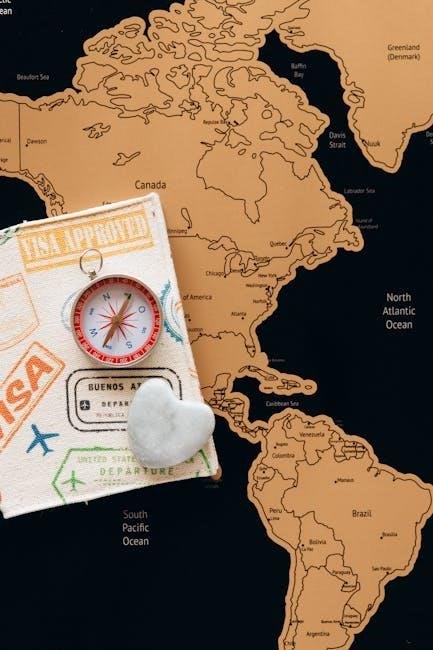AP World Unit 1 Study Guide: The Global Tapestry
This guide covers the foundational concepts of AP World History Unit 1, exploring early civilizations, agricultural revolutions, and global interactions. It provides study strategies and resources for success.
Welcome to AP World History Unit 1, which sets the foundation for understanding the modern world by exploring the earliest human societies and their development. This unit covers the period from approximately 1200 BCE to 500 CE, focusing on the emergence of civilizations, agricultural revolutions, and early global interactions. Key themes include the rise of river valley civilizations, the impact of environmental factors, and the development of political and social systems. Students will analyze how early societies adapted to their surroundings, exchanged goods and ideas, and laid the groundwork for future empires. To succeed, utilize study guides, flashcards, and video reviews to master concepts like the Global Tapestry and early trade networks. This unit is crucial for building a strong understanding of historical patterns that shape the world today.
1.2 Key Concepts: The Global Tapestry

The concept of the Global Tapestry in AP World History Unit 1 emphasizes the interconnectedness of early human societies. It highlights how diverse cultures and regions were linked through trade, migration, and cultural exchange. Key themes include the development of agriculture, the rise of river valley civilizations, and the spread of technologies like writing and metallurgy. Environmental factors, such as geography and climate, played a significant role in shaping societies. The Global Tapestry also explores the emergence of social hierarchies and gender roles, as well as the influence of religious and political systems. Understanding these interactions is essential for grasping how early societies laid the foundation for modern global connections. Utilize study guides and video reviews to delve deeper into these concepts and their significance in world history.

Early Civilizations and Agricultural Revolutions
Early civilizations emerged near river valleys, fostering agriculture, surplus, and specialization. The Neolithic Revolution marked the shift from nomadic to settled farming, enabling urban development and complex societies.
2.1 The Rise of Early River Valley Civilizations
The rise of early river valley civilizations, such as Mesopotamia, Egypt, the Indus Valley, and China, was driven by fertile land and water resources. These regions saw the development of agriculture, leading to surplus food and population growth. surplus enabled the emergence of specialized labor, urban centers, and complex societies. Innovations like writing (e.g., cuneiform in Mesopotamia), governance systems (e.g., pharaohs in Egypt), and architecture (e.g., ziggurats and pyramids) defined these civilizations. Geography played a crucial role, with rivers providing sustenance and shaping cultural practices. For example, the Nile’s annual flooding in Egypt and the Tigris-Euphrates in Mesopotamia supported irrigation and agriculture. These early societies laid the foundation for modern civilizations, emphasizing the importance of environmental adaptation and technological advancements. Their legacies include legal systems, religious beliefs, and artistic achievements that influenced future cultures.
2.2 The Impact of Agricultural Revolutions
Agricultural revolutions transformed human societies by introducing domesticated plants and animals. The Neolithic Revolution marked a shift from nomadic hunting to settled farming, enabling population growth and surplus food production. This surplus supported the rise of specialized labor, leading to the development of cities and complex societies. New tools and techniques, such as the plow, increased efficiency and further boosted agricultural output. The domestication of animals provided additional labor and food sources, enhancing overall productivity. These changes reshaped social structures, fostering trade and cultural exchange. The reliance on agriculture also led to the emergence of early political systems to manage resources. The impact of these revolutions was profound, laying the groundwork for the rise of civilizations and shaping the course of human history. Their legacy continues to influence modern agricultural practices and societal structures.

Early Empires and Their Legacies
Early empires like Mesopotamia, Egypt, and China established governance systems, cultural traditions, and technological advancements. Their legacies shaped political structures, religious practices, and societal norms for future civilizations.
3.1 Mesopotamia: The Cradle of Civilization
Mesopotamia, located between the Tigris and Euphrates rivers, is renowned as the “Cradle of Civilization.” It was home to several influential empires, including the Sumerians, Akkadians, Babylonians, and Assyrians. The Sumerians made significant contributions, such as the invention of cuneiform, one of the earliest known writing systems, which facilitated record-keeping and literature. They also developed sophisticated irrigation systems, enabling agriculture in the fertile but arid region. Mesopotamian cities, like Ur and Babylon, became centers of trade, culture, and governance. The Code of Hammurabi, established by the Babylonians, is one of the earliest surviving legal codes, reflecting the advancement of law and justice. These innovations laid the foundation for future civilizations, making Mesopotamia a pivotal region in world history.
3.2 Ancient Egypt: The Nile River Civilization
Ancient Egypt emerged along the Nile River, whose annual floods created fertile soil, enabling agriculture and supporting a stable population. Egyptian civilization is renowned for its monumental architecture, including the pyramids, which symbolize their advanced engineering and religious beliefs. The development of hieroglyphics, one of the earliest writing systems, facilitated record-keeping, storytelling, and governance. Egyptian society was highly structured, with the pharaoh at the apex, believed to be a divine intermediary. Religion played a central role, with a pantheon of gods and a complex afterlife belief system. The Nile’s reliability allowed Egypt to develop a prosperous and enduring civilization, influencing later cultures through its contributions to architecture, governance, and religious practices. This “gift of the Nile” made Egypt a cornerstone of early civilization and global history.
3.3 The Indus Valley Civilization
The Indus Valley Civilization thrived from around 2600 to 1900 BCE in the Indus River region, modern-day Pakistan and northwest India. Known for its advanced urban planning, cities like Harappa and Mohenjo-Daro featured grid layouts, drainage systems, and standardized brick construction. Trade networks stretched across Mesopotamia and other regions, exchanging goods like cotton, beads, and metals. The civilization’s script remains undeciphered, limiting our understanding of their governance and social structures. Artifacts suggest a sophisticated culture with a focus on crafts and trade. The Indus Valley’s emphasis on hygiene and public infrastructure was unparalleled for its time, showcasing a high level of civic organization. This civilization’s legacy lies in its contributions to early urbanization and trade systems, setting precedents for future societies in the region and beyond.
3.4 Early Chinese Civilizations
Early Chinese civilizations, emerging along the Yellow River, laid the foundation for one of the world’s most enduring cultures. The Shang Dynasty (1600–1046 BCE) introduced writing through Oracle Bones, while the Zhou Dynasty (1046–256 BCE) established the Mandate of Heaven, legitimizing rulers. The Qin Dynasty (221–206 BCE) unified China, creating a centralized bureaucracy and the Great Wall. The Han Dynasty (206 BCE–220 CE) expanded trade via the Silk Road and solidified Confucianism. Technological advancements, such as the Terracotta Army and iron tools, showcased innovation. Philosophical traditions like Confucianism, Daoism, and Legalism shaped societal values. These civilizations’ legacies include administrative systems, cultural practices, and philosophical frameworks that influenced East Asia and beyond, leaving a lasting impact on world history.

Early Global Interactions and Networks
This section explores the emergence of global trade networks, cultural exchanges, and their impact on early societies, shaping interconnectedness across regions and civilizations.
4.1 Early Trade Networks and Cultural Exchange
Early trade networks, such as the Silk Road, facilitated the exchange of goods, ideas, and cultures between civilizations. These networks connected regions like China, India, and the Mediterranean, fostering economic and cultural ties. The spread of religions such as Buddhism and Islam was also influenced by these trade routes. Cultural exchange led to the sharing of technologies, languages, and art, shaping the development of early societies. For example, the introduction of the wheel and metallurgy revolutionized agriculture and warfare. Additionally, the exchange of crops and spices enriched diets and economies. These interactions laid the foundation for global interconnectedness, demonstrating how early societies influenced one another despite geographical distances. Understanding these networks is crucial for analyzing the complexities of cultural and economic exchange in early world history.
4.2 The Role of Religion in Early Societies
Religion played a central role in shaping early societies, serving as a unifying force and providing moral and ethical frameworks. Many early religions were polytheistic, with deities representing natural phenomena. Rituals and practices became integral to daily life, influencing art, governance, and cultural identity. For example, ancient Mesopotamia’s religious beliefs influenced their legal systems, while in Egypt, religion was closely tied to the pharaoh’s divine authority. The spread of religions like Buddhism and Islam through trade networks further highlights their impact on cultural exchange. Religion also provided a shared sense of purpose, fostering social cohesion and explaining the unknown. Its influence on art, literature, and laws underscores its significance in early civilizations. Understanding the role of religion in early societies is essential for grasping their cultural and social structures.

Key Themes and Patterns in Unit 1

Unit 1 explores themes like political systems, environmental impact, and social structures, highlighting patterns in early civilizations’ development and interactions across diverse regions and cultures.

5.1 The Development of Political Systems
The development of political systems in early civilizations was shaped by geography, resources, and social hierarchies. River valley civilizations like Mesopotamia and Egypt established centralized governments, with leaders often justified through divine legitimacy. Mesopotamia saw the rise of city-states governed by councils and kings, while Egypt developed a pharaonic system with a powerful central authority. The Indus Valley Civilization, though less documented, suggests a well-planned urban structure indicative of centralized control. Early Chinese societies evolved from tribal leaders to hierarchical systems, eventually forming dynasties. Key concepts include the role of law codes, such as Hammurabi’s Code, which formalized governance and justice. These systems laid the groundwork for later empires, emphasizing administration, legitimacy, and the integration of religion into politics. Understanding these political structures is crucial for analyzing their lasting impacts on global governance patterns.
5.2 The Role of Environment and Geography
The environment and geography played a pivotal role in shaping early civilizations. River valleys, such as the Tigris-Euphrates, Nile, and Indus, provided fertile land and water for agriculture, fostering population growth and urbanization. The Nile’s annual floods, for example, created a dependable agricultural system in Egypt. Mountainous and desert regions often acted as natural barriers, influencing the development of distinct cultural and political systems. Climate and terrain also dictated trade routes and cultural exchange, with regions like Mesopotamia serving as crossroads for goods and ideas. Additionally, environmental challenges, such as arid conditions in the Fertile Crescent, spurred innovations in irrigation and governance. Understanding the interplay between geography and human activity is essential for analyzing the rise and evolution of early civilizations.
5.3 Social and Gender Structures
Social and gender structures in early civilizations were often hierarchical and influenced by religious, cultural, and economic factors. Most societies were divided into distinct classes, with elites, religious leaders, and rulers at the top, followed by farmers, artisans, and laborers. Gender roles were typically defined, with women often relegated to domestic spheres and men dominating public and political realms. However, some civilizations, like ancient Egypt, allowed women to hold significant religious and social power. Patriarchal systems were common, but exceptions existed, such as female leaders in certain contexts. These structures shaped legal codes, religious practices, and daily life, reinforcing social norms and inequalities. Understanding these dynamics helps in analyzing the complexities of early societies and their legacies in modern times.

Study Tips and Resources for Unit 1
Utilize study guides, flashcards, and video reviews for Unit 1. Effective strategies include creating concept maps and timelines. Explore resources like Knowt and YouTube for comprehensive reviews and practice questions.
6.1 Effective Study Strategies for AP World History
Effective study strategies for AP World History involve active engagement with course materials. Create detailed timelines and concept maps to visualize historical connections. Use flashcards to memorize key terms and events. Practice with past exam questions to familiarize yourself with the format. Join study groups to discuss complex topics and gain new insights. Regularly review notes and readings, summarizing them in your own words. Utilize online resources like YouTube videos and study guides for additional support. Develop a study schedule to ensure consistent preparation. Focus on understanding broader themes and patterns rather than just memorizing dates. Engage with primary sources to deepen your analysis. Seek feedback from teachers or peers to refine your study approach.
6;2 Recommended Resources and Study Guides
For success in AP World History Unit 1, utilize a variety of study resources. Khan Academy offers detailed video lessons and practice exercises. The College Board provides official study guides and sample questions. YouTube channels like “AP World History: Modern” offer comprehensive video reviews. Flashcards on platforms like Quizlet can help memorize key terms. The “AP World History: Modern” textbook and online companion resources are essential. Additionally, online forums and study groups provide collaborative learning opportunities. Use timelines and concept maps to visualize historical connections. Practice with past exam questions to build familiarity with the format. Supplement your studies with primary sources and scholarly articles for deeper understanding. Regularly review and organize your notes to reinforce learning. These resources will help you master the content and prepare effectively for the exam.

Mastering Unit 1 of AP World History sets a strong foundation for the entire course. By understanding early civilizations, agricultural revolutions, and global interactions, students gain insights into the origins of human societies. The key themes of political systems, environmental influences, and social structures provide a framework for analyzing historical patterns. Effective study strategies, such as active note-taking, timeline creation, and practice exams, are crucial for success. Utilize recommended resources like Khan Academy, YouTube tutorials, and official study guides to reinforce learning. Stay organized, engage with study groups, and regularly review concepts to build confidence. Remember, consistent effort and critical thinking are essential for excelling in AP World History. With dedication and the right tools, students can achieve their goals and develop a deeper understanding of the global tapestry.





